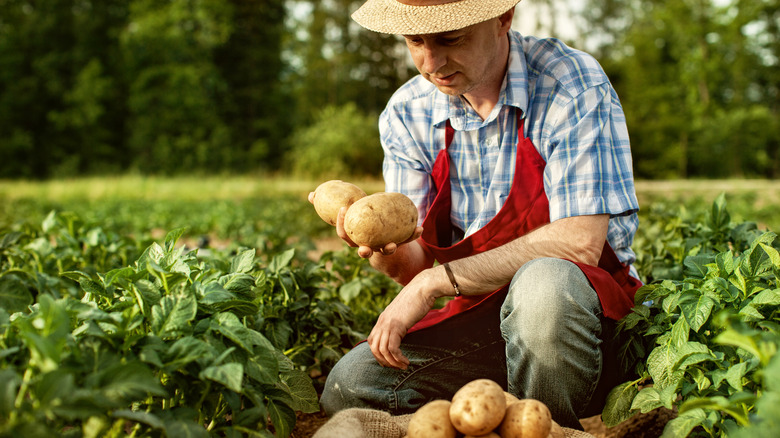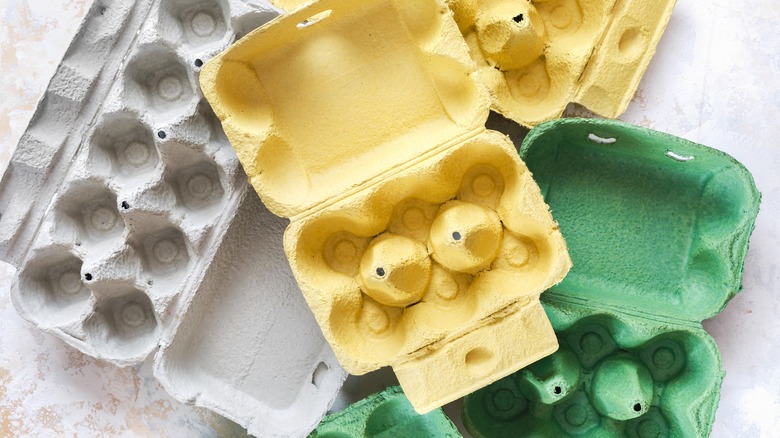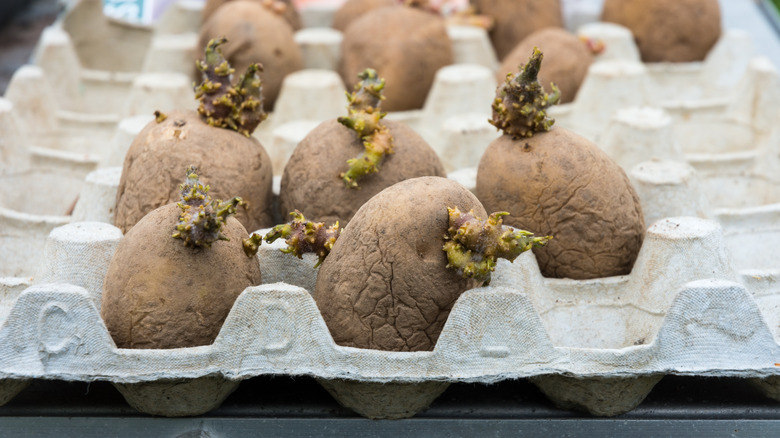Use This Unexpected Kitchen Waste To Grow Potatoes In No Time
Potatoes have a long growing season, so they need to be planted right at the start of spring if you hope to harvest any potatoes at all come summer. Sometimes, despite our best efforts and investment in the very best quality seed potatoes, these staple root vegetables don't give us the crops we dream of. Hungry gardeners at the end of their tether can try a process called chitting to start their seed potatoes faster — and get edible potatoes in the pot and on the table sooner. All you need is an empty cardboard egg carton (that's the unexpected kitchen scrap), some seed potatoes, and a sunny kitchen windowsill or sheltered spot on a patio.
Do you even need to chit your seed potatoes? After all, un-sprouted tubers planted directly into the ground at the right time (read: early to mid-spring) will also produce a healthy vine. But that's a gardening mistake everyone makes when growing potatoes. If you want to get started on your crop early, ensure all the seed potatoes you bought sprout, grow the healthiest possible vines, and perhaps most importantly, harvest a lot of delicious produce sooner — chitting is the way to go. Chitting is referred to as such in the U.K., where almost every gardener does it. The practice is common in North America, too, but you're more likely to see it referred to as greening, greensprouting, or pre-sprouting.
Gather the goods
Egg cartons make the perfect potato sprouting vessels. Either plastic or cardboard works just fine, though using a cardboard egg carton reduces the chance of moisture building up underneath the potato, potentially leading to it rotting. If you're using the style with the lid, cut it off using sharp scissors. Size doesn't matter — if you have a cavity for each seed potato you want to sprout, you're good to go. Take some time to identify an ideal chitting spot in or around your home, too. The place you plan to green your potatoes should be bright, dry, and not too hot or too cool. Sunny windowsills, sunrooms, greenhouses, or a sheltered area on a porch or patio all work well.
First up, don't be tempted to use those shriveled potatoes you found in the back of the pantry the other day. For one, grocery store potatoes are often sprayed with sprout inhibitors, chemical additives that stop the tuber from germinating. Plus, they might carry diseases you really don't want to introduce into your currently healthy garden. Buy, instead, early-season seed potatoes from a respected nursery in mid to late winter. Wood Prairie Family Farm in Maine has eight early-season organic potato varieties available, starting at $14.99 for a 1-pound bag. Similarly, Washington-based Irish Eyes has well over a dozen cultivars, some selling for as low as $12 a pound. Bonus: early season potatoes are less affected by diseases common to the species, like the dreaded blight.
Sturdy sprouts
Inspect each tuber carefully for signs of disease when your seed potato bag arrives. Discard any that don't look healthy. Count your seed potatoes and the cavities in your egg cartons to make sure you have a comfortable cavity to tuber ratio. There should only be a single layer of potatoes and one potato per cavity. If the potatoes are already budding, identify the rose — the largest cluster of nodes — on each and place the tubers into the hole with that facing up. If they're not, look for the biggest eye (where the sprouts start from) and place that facing up. Potatoes larger than an egg can be cut in half; ensure each half has at least one eye. Though it may seem counterintuitive to gardeners used to sprouting seeds, don't add potting mix and keep the egg cartons dry.
Place the trays in your pre-selected spot, somewhere with little foot traffic since potato shoots are fragile, and wait about six weeks for potatoes to develop sprouts strong enough to plant. What you're looking for is short, dark green to purple seedlings with small leaves starting to appear. If the sprouts look leggy and pale, move the tray to an area with more sunlight. If you wish, you can snap off some of the weaker sprouts, giving more energy to the remaining ones. A seed potato is ready to plant once its shoots have hardened.


